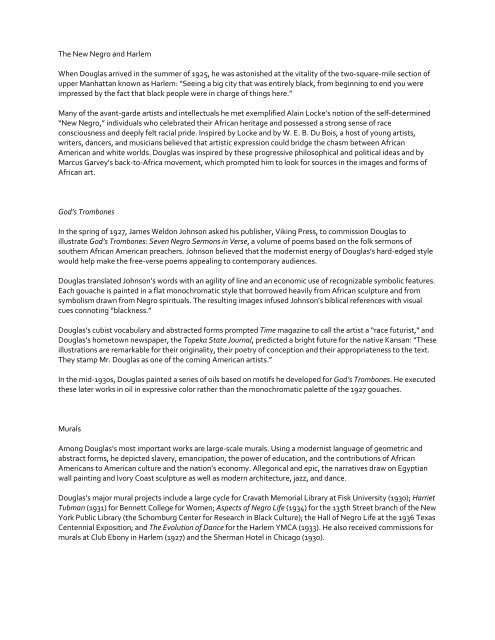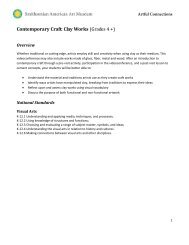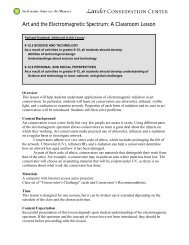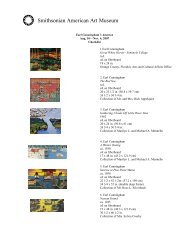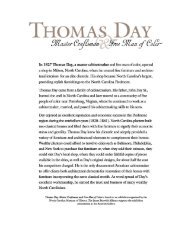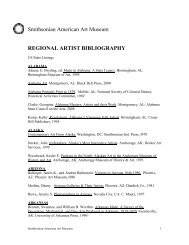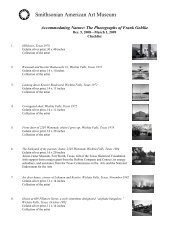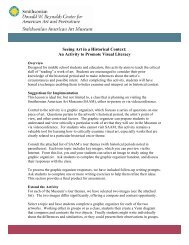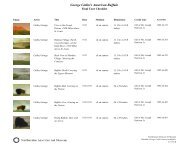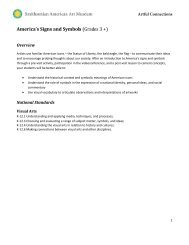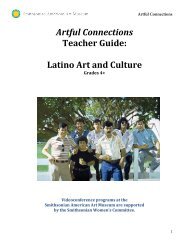Smithsonian American Art Museum Wall Text & Extended Labels
Smithsonian American Art Museum Wall Text & Extended Labels
Smithsonian American Art Museum Wall Text & Extended Labels
You also want an ePaper? Increase the reach of your titles
YUMPU automatically turns print PDFs into web optimized ePapers that Google loves.
The New Negro and Harlem<br />
When Douglas arrived in the summer of 1925, he was astonished at the vitality of the two‐square‐mile section of<br />
upper Manhattan known as Harlem: “Seeing a big city that was entirely black, from beginning to end you were<br />
impressed by the fact that black people were in charge of things here.”<br />
Many of the avant‐garde artists and intellectuals he met exemplified Alain Locke’s notion of the self‐determined<br />
“New Negro,” individuals who celebrated their African heritage and possessed a strong sense of race<br />
consciousness and deeply felt racial pride. Inspired by Locke and by W. E. B. Du Bois, a host of young artists,<br />
writers, dancers, and musicians believed that artistic expression could bridge the chasm between African<br />
<strong>American</strong> and white worlds. Douglas was inspired by these progressive philosophical and political ideas and by<br />
Marcus Garvey’s back‐to‐Africa movement, which prompted him to look for sources in the images and forms of<br />
African art.<br />
God’s Trombones<br />
In the spring of 1927, James Weldon Johnson asked his publisher, Viking Press, to commission Douglas to<br />
illustrate God’s Trombones: Seven Negro Sermons in Verse, a volume of poems based on the folk sermons of<br />
southern African <strong>American</strong> preachers. Johnson believed that the modernist energy of Douglas’s hard‐edged style<br />
would help make the free‐verse poems appealing to contemporary audiences.<br />
Douglas translated Johnson’s words with an agility of line and an economic use of recognizable symbolic features.<br />
Each gouache is painted in a flat monochromatic style that borrowed heavily from African sculpture and from<br />
symbolism drawn from Negro spirituals. The resulting images infused Johnson’s biblical references with visual<br />
cues connoting “blackness.”<br />
Douglas’s cubist vocabulary and abstracted forms prompted Time magazine to call the artist a “race futurist,” and<br />
Douglas’s hometown newspaper, the Topeka State Journal, predicted a bright future for the native Kansan: “These<br />
illustrations are remarkable for their originality, their poetry of conception and their appropriateness to the text.<br />
They stamp Mr. Douglas as one of the coming <strong>American</strong> artists.”<br />
In the mid‐1930s, Douglas painted a series of oils based on motifs he developed for God’s Trombones. He executed<br />
these later works in oil in expressive color rather than the monochromatic palette of the 1927 gouaches.<br />
Murals<br />
Among Douglas’s most important works are large‐scale murals. Using a modernist language of geometric and<br />
abstract forms, he depicted slavery, emancipation, the power of education, and the contributions of African<br />
<strong>American</strong>s to <strong>American</strong> culture and the nation’s economy. Allegorical and epic, the narratives draw on Egyptian<br />
wall painting and Ivory Coast sculpture as well as modern architecture, jazz, and dance.<br />
Douglas’s major mural projects include a large cycle for Cravath Memorial Library at Fisk University (1930); Harriet<br />
Tubman (1931) for Bennett College for Women; Aspects of Negro Life (1934) for the 135th Street branch of the New<br />
York Public Library (the Schomburg Center for Research in Black Culture); the Hall of Negro Life at the 1936 Texas<br />
Centennial Exposition; and The Evolution of Dance for the Harlem YMCA (1933). He also received commissions for<br />
murals at Club Ebony in Harlem (1927) and the Sherman Hotel in Chicago (1930).


